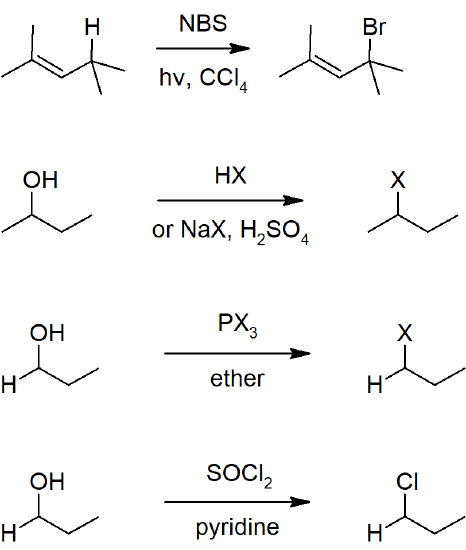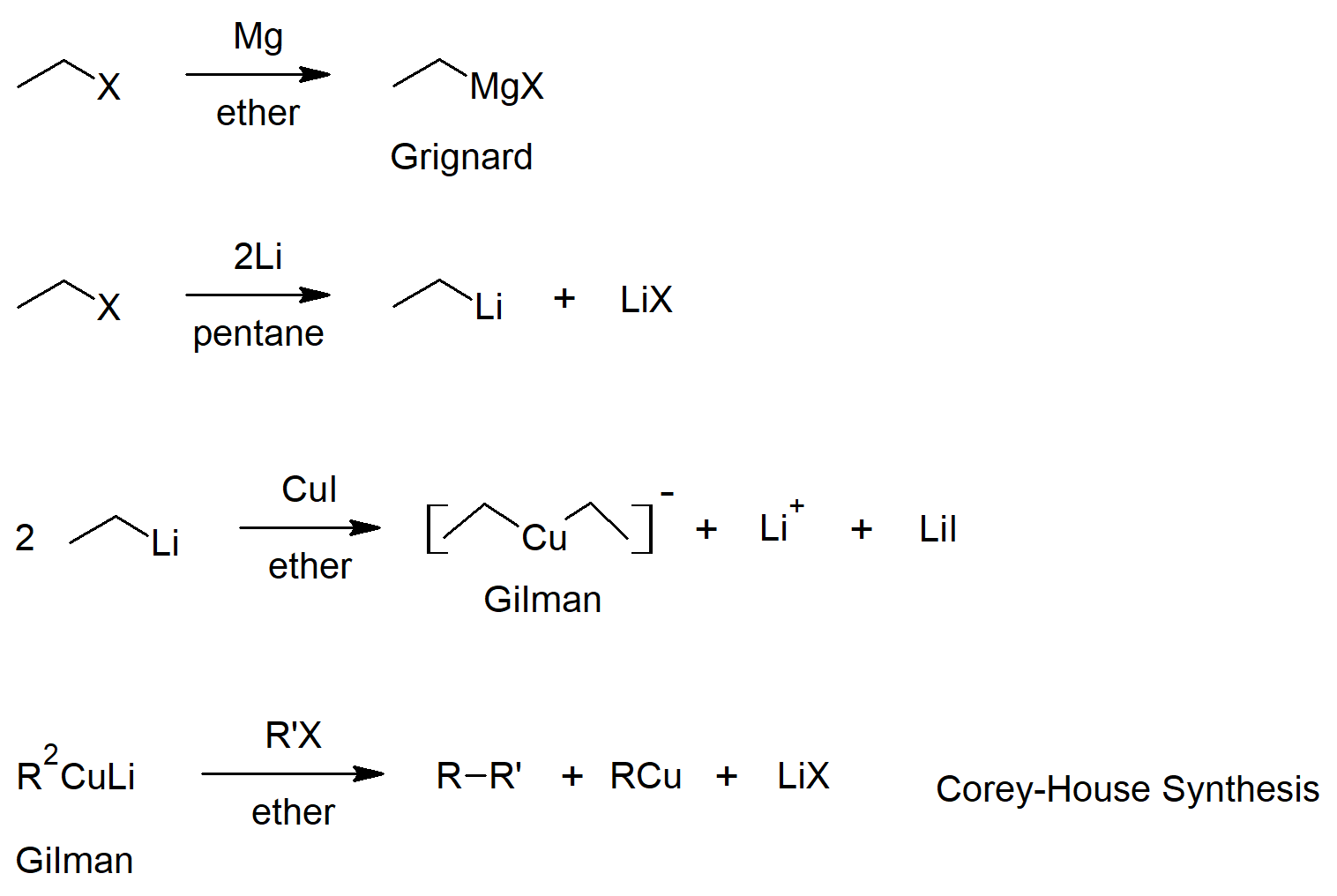10.S: Organohalides (Summary)
( \newcommand{\kernel}{\mathrm{null}\,}\)
Concepts & Vocabulary
10.1 Introduction to Organohalides
- Alkyl halides (and allyl and benzyl halides) are more reactive than vinyl and aryl halides.
10.2 Names and Properties of Alkyl Halides
- Reactivity of alkyl halides is often related to the substitution of the carbon atom the halogen is attached to.
- Alkyl halides are categorized by the number of bonds to other alkyl groups (primary, secondary, and tertiary).
- Carbon-halogen bonds are polarized with partial positive charges on carbon and partial negative charges on the halogen.
- Fluorine is the most electronegative of the halogens while iodine is the least electronegative.
- Iodine is the largest of the halogens yielding the longest/weakest bonds to carbon of the halogens.
- Since haloalkanes have dipole-dipole interactions, they have greater intermolecular forces than similar sized alkanes and therefore higher boiling points.
- Alkyl halides are either slightly soluble or insoluble in water, but are soluble in organic solvents.
10.3 Preparing Alkyl Halides from Alkanes - Radical Halogenation
- Halogenation of alkanes is exothermic, so it is energetically favorable.
- Radical chain mechanisms consist of three steps: initiation, propagation and termination.
- Hydrogens on more substituted carbon atoms are more reactive to radical halogenation.
10.4 Preparing Alkyl Halides from Alkenes - Allylic Bromination
- More substituted radicals and radicals with resonance structures are more stable than other radicals.
- Radical substitution can be carried out at the allylic or benzylic carbon by reacting with NBS.
10.5 Stability of the Allyl Radical - Resonance Revisited
- Allyl cations, anions and radicals have resonance structures. To draw these resonance structures non-bonded and pi-bond electrons can be moved.
- Resonance hybrids are used to show the combination of all resonance structures for a molecule or ion.
10.6 Preparing Alkyl Halides form Alcohols
- Alcohols can be reacted with hydrohalogen acids or a mixture of halogen salts and a stronger acid (to form hydrohalogen acids in situ).
- Alcohols will also react with thionyl chloride or with phosphorus halides to from haloalkanes.
10.7 Reactions of Alkyl Halides - Grignard Reactions
- Organometallic reagents can be formed from alkyl halides and reactive metals (such as lithium and magnesium).
- Alkyl magnesium halide compounds are callled Grignard reagents.
- Grignard reagents react as bases where the alkyl group gets protonated and the metal complexes to the conjugate base of the reacting acid.
10.8 Organometallic Coupling Reactions
- Lithium dialkyl copper compounds are called Gilman reagents.
- Gilman reagents have different reactivity from the other organometallics (lithium and Grignard reagents).
- Organometallics can be reacted with alkyl halides to join to alkyl groups (coupling reactions).
10.9 Oxidation and Reduction in Organic Chemistry
- Gaining bonds to hydrogen for organic molecules is reduction.
- Losing bonds to hydrogen for organic molecules is oxidation.
Skills to Master
- Skill 10.1 Differentiate between types of halides (alkyl, allyl, aryl, benzyl, and vinyl).
- Skill 10.2 Differentiate between substitution of alkyl halides (primary, secondary, and tertiary).
- Skill 10.3 Identify relative reactivity of carbon-hydrogen bonds to radical halogenation.
- Skill 10.4 Draw resonance structures for radical compounds.
- Skill 10.5 Draw mechanisms for radical halogenation of alkanes (initiation, propagation and termination).
- Skill 10.6 Calculate the enthalpy change of a reaction using bond dissociation energies of reactants and products.
- Skill 10.7 Determine products for allylic bromination reactions.
- Skill 10.8 Draw resonance structures for allylic and other similar compounds and ions.
- Skill 10.9 Draw products of reactions of alcohols to form alkyl halides.
- Skill 10.10 Write equations to form Grignard reagents from alkyl halides.
- Skill 10.11 Draw reaction products for Grignard reagents acting as bases.
- Skill 10.12 Write equations for the formation of Gilman reagents.
- Skill 10.13 Draw reaction products of organometallic coupling reactions.
- Skill 10.14 Explain oxidation and reduction in organic molecules.
Summary of Reactions
Preparation of Alkyl Halides

Reactions Alkyl Halides
Contributors
- Layne Morsch (University of Illinois Springfield)
Dr. Dietmar Kennepohl FCIC (Professor of Chemistry, Athabasca University)


